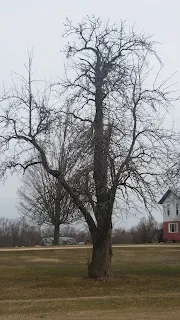One of my brothers was telling me about a co-worker who had recently lost a brother.
My brother and his co-worker are both in high-octane professions. The deceased brother's life had been much harder and much beset with misfortune.
My brother was mulling over the idea of suggesting that his co-worker plant a tree to honor his brother. He asked what I thought of fruit trees for the purpose.
I told him that most fruit trees don't live very long. There are, however, some notable exceptions. The Endicott Pear, for instance which was planted approximately 1640 and is still alive in the same site today.
Lost legacy
Since my youth, I venture that half of the "big" pear trees have fallen to the chainsaw.
It takes a cluster of attributes for a fruit tree to survive a hundred years of age. It must produce enough fruit of high enough quality to convince the owners to not remove it. Since one-hundred-years averages five-to-ten owners, that by itself is a significant accomplishment.
It must be vigorous enough to outgrow trunk rots. Fruit-wood is not very rot resistant but as long as the tree keeps adding girth it can outrun the inevitable...for a while.
As odd as it sounds, it must not over-bear fruit or it will runt-out or enter winter with low metabolic reserves and suffer extreme winter kill.
It must be resistant to the extremes of the site's weather.
It must have been planted on a site that was favorable for the species.
It must avoid lightning.
It must have sufficient disease resistance to avoid decline or death.
Road trip
I hopped into the S-10 and went collecting.
 |
| If you look to the left of the barn you will see a carriage and the foundation of the house is dressed field stone. |
 |
| The West tree. |
 |
| The East tree |
 |
| The West tree. It is tough to measure girth without a helper. I would remove about ten inches to account for suckers and the poison ivy vine. |
 |
| The East tree |
The Michigan Big Tree has a girth of 136" so these are not in the running at roughly 90" but they are still fine, old trees that could easily be 100 years old.
I saw these trees in fruit and suspect one of them might be the variety "Douglas" which entered commerce in 1907.
I was able to collect scion from both trees.
Another tree on my list might be Tyson but the abandoned farm yard is plastered with "No Trespassing" signs. I am tempted to risk it. I use a clothes pin to clip a $5 bill to a twig and then collect my scion wood. If challenged, I can claim I wasn't exactly stealing the twig.
If any readers know of any exceptionally large pear trees (arbitrarily 72" in girth) within thirty miles of Eaton Rapids, I would be delighted to collect a scion or two and propagate them. Even if these trees were "common" varieties, it is a shame to lose the identity of exactly which varieties they were.
What rootstock will you graft onto? Or another tree?
ReplyDeleteI have a row of young Shenandoah pears that I will be changing over. I originally was going to change them to half Korean Giant Asian pear and half Chojuro. Both are very late pears with incredibly long hang-times.
DeleteA monument tree is a great idea. We planted a Flowering Dogwood for my grandmother 20 years ago and it's still there and growing.
ReplyDeleteWhen I was growing up in west Texas my neighbor had a pear tree about 45 feet tall. It had the best pears I have ever tasted. I would like to know where I could get one or two of this kind of pear?
ReplyDelete